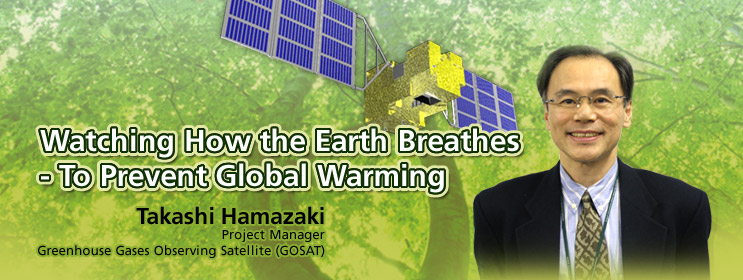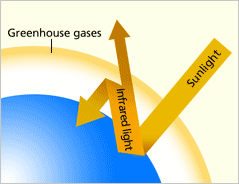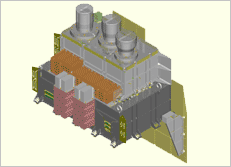


Structural Thermal Model (STM) of the Greenhouse Gases Observing Satellite (GOSAT)
Q. What are the primary objectives of GOSAT?
GOSAT has three major mission objectives. The first is to monitor the density of greenhouse gases precisely and frequently worldwide. Greenhouse gases are the major cause of global warming. Carbon dioxide (CO2) represents 60 percent of greenhouse-gas effects; methane makes up another 20 percent. GOSAT will measure the distribution of these two main greenhouse gases density in detail.
The second mission objective is to study the absorption and emission levels of greenhouse gases per continent or large country over a certain period of time. The Kyoto Protocol, which came into effect on February 2005, requires that developed nations reduce greenhouse-gas emissions between 2008 and 2012. The target for Japan is 6 percent below 1990 levels, for the United States it is 7 percent, and for the European Union it is 8 percent; however in reality, there are no standardized means to measure greenhouse-gas emissions, and the amount of emissions reported is based on self-declaration. The amount is calculated based on assumptions about the volume of the countries' oil consumption, car-driving distances and industrial gas emissions, for example. Therefore if GOSAT observation makes it possible to estimate greenhouse-gas absorption and emission per continent or large country, we'll be able to use the data as a means of verification.
And the last objective is to develop and establish advanced technologies that are essential for precise greenhouse-gas observations.
Q. How do greenhouse gases increase the Earth's temperature?

Schematics of Greenhouse gas effects
The temperature of the Earth's atmosphere is determined by the balance between the energy received from the Sun and the energy radiated into outer space. Most energy from the Sun is transmitted through visible light. The visible light reaches through the atmosphere and warms the Earth's surface, and the heat of the surface is radiated as infrared light back to space. When the energy received is greater than the energy released, the Earth's temperature rises; when it's the reverse, the temperature decreases. Greenhouse gases have a special property to absorb infrared light and consequently prevent radiated heat from leaving the Earth. Therefore in principle, the more greenhouse gases there are, the higher the Earth's temperature rises. But the fact is that our life would be difficult to sustain without any greenhouse gases at all. The average temperature of Earth is around 15degreeC. Without greenhouse gases, it is estimated to be -18degreeC; 33 degrees colder than the current average. Although we clearly need a certain amount of greenhouse gas, when we have an excess amount, we face not only a rise in the Earth's temperature but also climate change, which leads to unusual weather. Therefore it is very important to regulate and stabilize the density of greenhouse gases.

Greenhouse Gases Sensor (TANSO-FTS)

Cloud and Aerosol Imager (TANSO-CAI)
Q. What kind of observation instruments will GOSAT be equipped with?
GOSAT will have two sensors: the greenhouse gases sensor TANSO-FTS (Thermal And Near infrared Sensor for carbon Observation - Fourier Transform Spectrometer) and its auxiliary sensor, the Cloud and Aerosol Imager, TANSO-CAI.
TANSO-FTS will observe infrared light which is emitted from the Sun and then reflected at the ground surface. When infrared light passes through the gases such as CO2 and methane, only specific colors - that is, only specific wavelengths of the infrared light - are absorbed. Different gases absorb different wavelengths, and the amount of absorption is proportional to the density of the gases that the infrared light has penetrated. Based on this principle, the density of greenhouse gases in the atmosphere can be measured in detail.
TANSO-CAI is an auxiliary sensor to help increase the observation performance of TANSO-FTS, and observes clouds and aerosols, which can cause TANSO-FTS errors.
Clouds blocks the way of TANSO-FTS measurements near the Earth's surface. TANSO-FTS measures reflected light from the ground; however if there is a cloud, the sensor would observe a light reflected at the cloud's surface, and the density of gases in the atmosphere close to the ground would not be accurately measured. TANSO-FTS is capable of making precise measurements at cloud-free condition, and therefore it's necessary to distinguish the existence of clouds by TANSO-CAI in order to correct the data.
Aerosols are fine airborne particles - anything from dust to sea salt. Different types of aerosols reflect light at different elevations, so understanding their effects is also essential to avoid errors.
Equipped with these two sensors, GOSAT is assigned with a single mission objective: to measure the density of greenhouse gases.